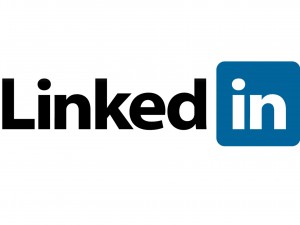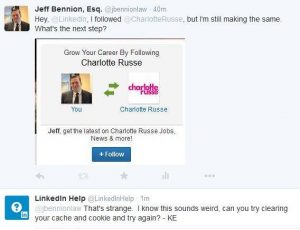A Lawyer's Guide to Social Media (Part 4): LinkedIn
LinkedIn can be a great marketing tool if you do it right, as tech columnist Jeff Bennion explains.
 Confession: I have never really understood LinkedIn and there are parts that I don’t like. It has a news feed, but that news feed is like someone took all of the sponsored content posts from Facebook that I skip past and put them all in one place. I’m not sure if any post has ever gone viral on LinkedIn.
Confession: I have never really understood LinkedIn and there are parts that I don’t like. It has a news feed, but that news feed is like someone took all of the sponsored content posts from Facebook that I skip past and put them all in one place. I’m not sure if any post has ever gone viral on LinkedIn.

I don’t understand the endorsement thing. Random people can endorse me for anything, including things that I do not do. A few years ago, I accepted a LinkedIn request from a guy from Washington who would then endorse me for random things every couple of days. Since I did not want to falsely advertise my specialties, I had to remove his endorsements for things like family law and sports law that I don’t do. I went to his LinkedIn page and saw that he has hundreds of endorsements for various skills. So, I guess the idea is he endorses me for things, then I endorse him. I also get random notifications to endorse my connections for things.

Navigating Financial Success by Avoiding Common Pitfalls and Maximizing Firm Performance
That being said, I think LinkedIn can be a great marketing tool if you do it right and if it fits your practice area. Different practice areas lend themselves better to different marketing tools. The best marketing tool is word of mouth. After that, you need to go to where your potential client pool is. For some, that’s Facebook (or Snapchat). For certain lawyers, the clients are on LinkedIn.
What Sets LinkedIn Apart
Like Twitter and unlike Facebook, LinkedIn is a place to connect with people that you don’t necessarily know in real life. If someone wants to connect with you on LinkedIn, they are not going to see albums of you and your family and your kids, just the information that you would put on a résumé. That makes building your connection network easier. You can also see who your connections’ connections are out to the second and third degree and connect with someone who is a friend of a friend. You need to be careful though because LinkedIn shows you who has looked at your profile, so you can’t stalk people on LinkedIn (easily).
Establish a Good Presence So That People Can Look You Up
Sponsored

The Business Case For AI At Your Law Firm


Navigating Financial Success by Avoiding Common Pitfalls and Maximizing Firm Performance

Is The Future Of Law Distributed? Lessons From The Tech Adoption Curve

Is The Future Of Law Distributed? Lessons From The Tech Adoption Curve
The first thing you should do is to fill out your LinkedIn profile with as much information as possible. Pictures and other media will help set your profile apart. Remember, LinkedIn is not the only place people are going to go online to research you. Choosing a lawyer online is just like choosing a TV or a car – there are numerous sites you can visit to gather information before you make a decision. LinkedIn is just going to be one of those sites that people go to when they look you up. The more information a potential customer or client has, the easier it is for them to feel comfortable choosing you.
LinkedIn’s Tools
Social media marketing is different from website SEO and buying Google ad words. It’s not about having people find you when they are searching, it’s about putting your information in front of people like a billboard. Then, when they need someone, they remember that they saw your ad or your profile and look you up. Once You have built out your profile and established connections, there some good ways on LinkedIn to pop up on your connections’ radars. LinkedIn gives you reminders of people’s work anniversaries and profile changes and prompts you to leave them a note or congratulate them. Be careful with this, though. Recently, I had a work anniversary and for the entire week, I was getting LinkedIn messages from people saying, “Congrats on the anniversary! Hope you are doing well!” There’s a button apparently that lets you automate that message out to someone on their work anniversary. Don’t do that. Write a custom note or don’t write one at all.
Participate in Groups
The best and least utilized feature in LinkedIn is the groups (including the Above the Law group). Groups allow you to form a group of professionals together and post questions or discussions. It’s a great way to showcase your expertise to people who might be clients. For example, if you are a corporate formations attorney in Little Rock, Arkansas, you can create or join a group for Small Businesses of Little Rock. Members can post questions, and you can participate in discussions. It doesn’t even have to be a legal-themed group. It could just be a group in your community. Interact with members of your community. They can see your profile, and when the other members of the group or their friends need help, they’ll know who to call.
Sponsored

Legal AI: 3 Steps Law Firms Should Take Now

Early Adopters Of Legal AI Gaining Competitive Edge In Marketplace
Earlier: A Lawyer’s Guide To Social Media (Part 1): Twitter
A Lawyer’s Guide to Social Media (Part 2): Facebook
A Lawyer’s Guide to Social Media (Part 3): How to Effectively Run Ads
Jeff Bennion is a solo practitioner at the Law Office of Jeff Bennion. He serves as a member of the Board of Directors of San Diego’s plaintiffs’ trial lawyers association, Consumer Attorneys of San Diego. He is also the Education Chair and Executive Committee member of the State Bar of California’s Law Practice Management and Technology section. He is a member of the Advisory Council and instructor at UCSD’s Litigation Technology Management program. His opinions are his own. Follow him on Twitter here or on Facebook here, or contact him by email at jeff@trial.technology.








